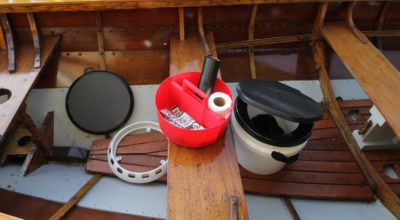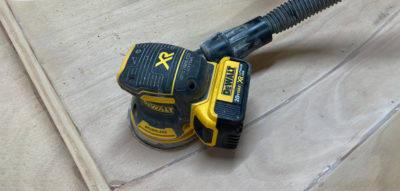It’s been a long time since I bought new binoculars. For many years I’ve used a pair I inherited that are decades old, but last summer, when I finally tired of the stiffness that had worked into all the moving pieces and the lack of a rubber cup on the left eyepiece, I decided the time had come.
There’s a wide variety of binoculars on the market ranging from very small to very complex, and from not-especially powerful to extraordinary levels of magnification. The price tags also range widely from well under $100 to well over $1,000. For a while I was confused by all the offerings, so I made a shortlist of needs: They must be waterproof, reasonably rugged, have a magnification of no less than 7 and objective lenses no smaller than 40mm; they should be fog-proof, comfortable to hold, no heavier than 2.5 lbs (which is what the old pair weighed), and cost less than $300. It would be nice if they also floated and had a compass.
 Photographs by the author
Photographs by the authorThe Hooway 7×50 Marine Binoculars are fully sealed and waterproof. The rubber eyecups can be folded back so that they can be used efficiently if wearing glasses.
The Hooway 7×50 Marine Binoculars ticked all the boxes.
The binoculars come with everything you need: a stiff nylon carrying case with a 1 1⁄2″-wide web shoulder strap and a belt loop on the back; a narrow nylon strap with a 1 3⁄4″ bright-yellow nylon pad to go behind the neck; an eyepiece cap; objective lens caps; a lens cleaning cloth; two replacement batteries (needed for the compass and rangefinder lighting system); and a nine-page instruction manual.
As soon as I lifted the binoculars out of the box, I liked their rugged but comfortable feel. They weigh just under 2 lbs—heavy enough to help with stability in a moving boat, but not so heavy that they are an effort to hold up. From lens cap to lens cap, they are just under 6″ long, and the maximum width ranges from 7 3⁄8″ when closed to 8 1⁄8″ when opened wide. The coating is a smooth black rubber except in the hand grips, which are textured and ridged to reduce slipping when wet and have thumb hollows right where you need them. The grips’ contrasting bright yellow means that the binoculars are easier to locate when they’ve settled in the bottom of a dark locker. The movement when reducing and expanding the body width to adjust for your eye position is satisfyingly stiff but smooth. The eyepieces have rubber eyecups that can be folded down if you are wearing glasses, but when fully extended they fit comfortably around the eyes.

The binoculars have a built-in rangefinder reticle. The calculator dial, seen here above the objective lens to the right, allows you to establish the distance or size of an object without having to do the math. The carrying strap includes a stretch of wider, padded nylon that rests comfortably on your neck.
Each eye lens has its own diopter adjustment ring so that it can be focused independently; there is no center focus. Once in focus the image is remarkably sharp and bright, 3D shapes and shadows appearing more defined than to the naked eye. Within the field of vision is a rangefinder reticle, with a horizontal scale and a vertical scale. The instruction manual devotes two pages to this tool and how to use it, written in clear English. The second of the two pages dives into the math needed to use the scales to estimate size of an object or distance to a known object, but for those with less mathematical inclination, the opening line advises the reader to skip to the next page where there is a description of the binoculars’ calculator dial and how to use it. The calculator has one moving dial with measurements for both view angle and object size, and one static dial for distance. It should be noted that the readings are in meters and kilometers.

The neck strap floats, but even without it the binoculars have sufficient buoyancy to hold them up on the water’s surface. If they’re dropped overboard while you’re underway, the bright yellow of the carrying strap and handgrips makes it easier to spot them.
Below the rangefinder reticle is a compass that reads to magnetic north—a range of 20° is displayed in the view. At times of low light both the compass and the rangefinder reticle can be illuminated red, so that while the binoculars do not offer night vision, they are useful for confirming position at night.
Of all the claims made by Hooway, the one of which I was most skeptical was “floating.” I tested this as soon as I unpacked the binoculars, but not wishing to commit my new purchase to the depths of the harbor, I filled the kitchen sink and lowered them in. They floated horizontally on the surface. I took them down to the town landing to carefully drop them into deeper water, and this time they floated with barely half of the body beneath the water. I was impressed. I recovered them and looked for signs of ingress of water in the lenses, but there was none, and that remains true several weeks later.![]()
Jenny Bennett is editor of Small Boats.
The Hooway 7×50 Marine Binoculars are available from multiple online outlets, for an average price of $140.
Is there a product that might be useful for boatbuilding, cruising, or shore-side camping that you’d like us to review? Please email your suggestions.












Jenny, It has been more than a long time that my family has kept our binoculars.. the family legend is that the U.S. entered WW1 woefully unprepared. So much so that it put out a call for folks to “lend” their binoculars to the war effort. The government promised to return them at some point in the future. Well, a pair was sent back but the family swore they were not exactly the ones lent. We still have them… perhaps we might upgrade from our hundred-year-old-plus binoculars—in a decade or two. Merry Christmas to all.
“Each eye lens has its own diopter adjustment ring so that it can be focused independently; there is no center focus.”
No center focus sounds like a problem.
Hi Robert, I haven’t found it to be a problem, but that might be because the vision in my two eyes is not the same. That said, for users who are accustomed to, and like, the center focus function, it will definitely be missed here.
This one does seem to check all the boxes, Jenny. Thanks for reviewing it. Ordering mine now as holiday gift to self :).
Not sure that waterproof and centerfocus are compatible. These seem a bargain, not a brand with which I was familiar, but floating and waterproof tics major boxes for a little row /sail boat.